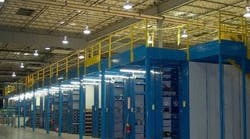The earthquake that delivered a terrifying blow to Japan’s people, infrastructure and businesses also had an economic impact around the world. Understanding the effect material handling can have on a global supply chain can start with a study of the structural integrity of mezzanines.
“While our entire planet is seismically active, there are particular areas in the world and within the U.S. that are more susceptible to earthquakes than others,” explains John Moore, vice president at Cubic Designs in New Berlin, Wisconsin. “Most Americans think about the west coast when it comes to earthquakes, but the New Madrid fault between Memphis and the area just south of St. Louis is an example of a more active seismic zone than most people realize. There are also seismic zones in South Carolina and in some northeastern states that deserve structural design consideration—areas that most people just don’t think of.”
Seismic Considerations
Mezzanine manufacturers must address the various seismic zones in their designs to ensure a safe structure wherever they are being installed. There are several critical areas to address when designing and building seismic-resistant structures, according to Moore.
• Column-to-beam connections. The connections where the framing members meet the column tops are one of the most critical design points for a mezzanine. More than 20 years ago, Cubic Designs’ structural connection standards included two designs: a “moment connection” design for high seismic areas, and another separate moment connection design for areas with little or no seismic activity. Over time, the company combined both of these designs into one standard solution, providing an efficient and safe design to its users in all areas of seismic activity.
• Welds. Proper welds are also critical to the structural integrity of the structure, especially in a dynamic situation like an earthquake. The length, penetration and quality of welds are all important factors, and in many cases are highly scrutinized by permit officials in high seismic zones.
• Concrete and Anchors. “A regular concrete slab may not always be enough to support a mezzanine,” Moore says. “Forces acting on a mezzanine are transferred through the structure to its foundation, and if the foundation’s concrete and soil base is not substantial enough to withstand those forces, a failure could occur. This is what no one wants. A structural failure could result in loss of property and even worse. Mezzanine column forces and reactions at the foundation should be determined at the design stage, and if an existing foundation system is not strong enough, then concrete footings should be installed to support the structure’s vertical and lateral loads during stress.”
• Anchor bolts. The tensile strength and overall pull-out strength of the bolt is a very important consideration, and should be specifically based on the location and conditions. Expansion anchors resist forces that prevent the bolt from coming out.
The foundation, the anchors, and the structure all work together as a system, and all of these are critical to the success of a safe mezzanine that will withstand the kind of forces that come with earthquakes.
Manufactured and installed properly, mezzanines serve as a safe way to create more operating space within a facility and foster more streamlined operations.
This article was contributed by Cubic Designs, Inc., makers of industrial mezzanine systems.





